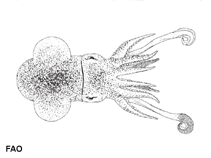Rossia macrosoma (Chiaie, 1830)
Stout bobtail| Native range | All suitable habitat | Point map | Year 2050 |

|
| This map was computer-generated and has not yet been reviewed. |
| Rossia macrosoma AquaMaps Data sources: GBIF OBIS |
Классификация / Names народные названия | синонимы | CoL | ITIS | WoRMS
Cephalopoda | Sepiida | Sepiolidae | Rossiinae
Environment: milieu / climate zone / пределы глубины / distribution range экология
; пределы глубины 32 - 899 m (ссылка 1695), usually 200 - 400 m (ссылка 1695). Temperate; 70°N - 13°N, 33°W - 36°E (ссылка 1695)
Distribution страны | регионы FAO | Ecosystems | места находок | интродукции
Eastern Atlantic and the Mediterranean: From East Greenland and Iceland to the Mediterranean and northwest Africa. Temperate to polar.
Length at first maturity / Size / Weight / Возраст
половая зрелость: Lm ? range ? - ? cm Max length : 10.0 cm ML самец/пол неопределен; (ссылка 122093)
Life cycle and mating behavior половая зрелость | размножение | нерест | Eggs | Fecundity | Larvae
Основная ссылка
ссылки | координатор | соавторы
Jereb, P. and C.F.E. Roper (eds.) 2005 Cephalopods of the world. An Annotated and Illustrated catalogue of Cephalopod species known to date. Vol. 1. Chambered nautiluses and sepioids (Nautilidae, Sepiidae, Sepiolidae, Sepiadariidae, Idiosepiidae and Spirulidae). FAO Spec. Cat. Fish. Purp. 4(1):262p. Rome: FAO. (ссылка 1695)
Статус Красного Списка МСОП
(ссылка 130435: Version 2025-1)
Статус СИТЕС (ссылка 108899)
CMS (ссылка 116361)
Угроза для людей
Использование человеком
рыболовство: не имеет хозяйственного значения
| FishSource |
инструменты
дополнительная информация
ресурсы в Интернет
BHL | BOLD Systems | CISTI | DiscoverLife | FAO(Publication : search) | Fishipedia | GenBank (Геном, Нуклеотид) | GloBI | Gomexsi | Google Books | Google Scholar | Google | PubMed | Tree of Life | Wikipedia (Вперёд, поиск) | Zoological Record



